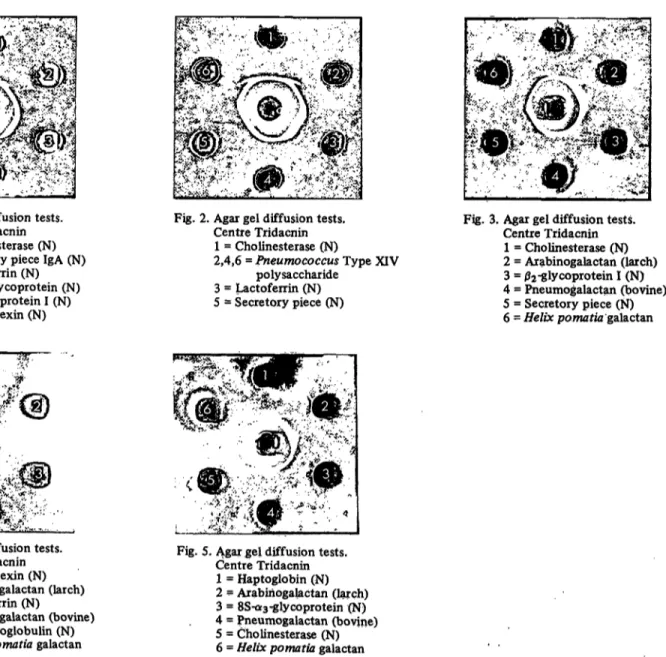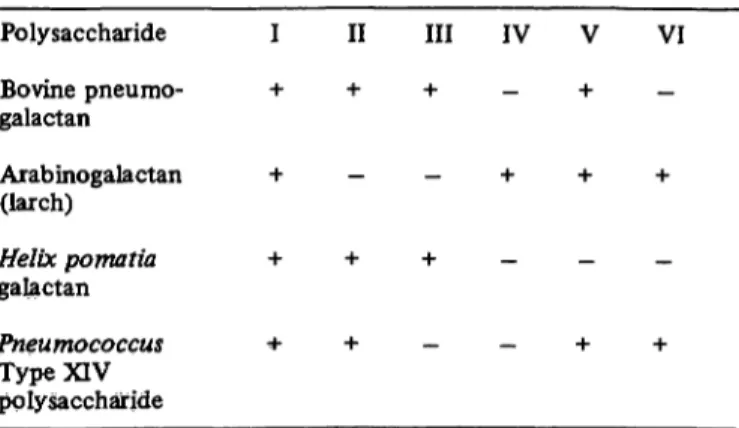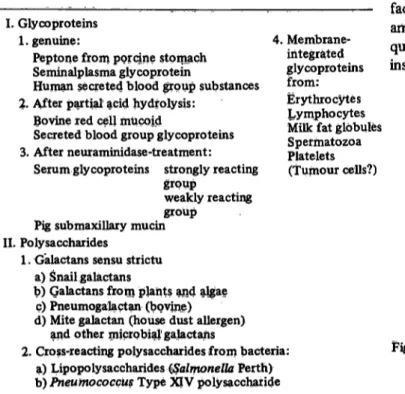J. Clin. Chem. Clin. Biochem.
Vol. 15,1977, pp. 21-26
A New Marker for Neuraminidase-Treated Human Serum Glycoproteins from the Haemolymph of Tridacna maxima (Boding)1)
By G. Uhlenbruck, G. Steinhausen
Department oflmmunobiology, Medical University Clinic Cologne and H. G Schwick
Behringwerke Marburg
(Eingegangen am 15. Juli/1. November 1976)
Summary: Highly purified human serum glycoproteins were treated with neuraminidase. The exposed subterminal carbohydrate structures reacted strongly with an anti-galactan precipitin from the haemolymph of Tridacna maxima which detects terminal, non-reducing ß-D-galactoside residues. This invertebrate precipitin, Tridacnin, may be used as a marker for nearly two thirds of all asialo serum glycoproteins. A number of different cross-reactions with various other polysaccharides and galactans subdivides those neuraminidase-treated glycoproteins into several subgroups, indicating that the uncovered carbohydrate structures are not always completely identical. In this way, together with the cross-reacting precipitins from plant and invertebrate origin, Tridacnin may be a useful tool for elucidating and establishing the structure of the carbohydrate part of serum glycoproteins.
Ein neuer Marker fur mit Neuraminidase behandelte Serum-Glykoproteine des Menschen aus der Hämolymphe von Tridacna maxima (Röding)
Zusammenfassung: Hochgereinigte menschliche Serum-Glykoproteine wurden mit Neuraminidase behandelt. Die dabei freigelegten subterminalen Kohlenhydratstrukturen reagierten stark mit einem Anti-Galactan Präzipitin aus der
Hämolymphe von Tridacna maxima, welches endständige, nicht-reduzierend gebundene ß-D-Galactosido-Reste erfaßt.
Dieses Präzipitin aus Invertebraten, Tridacnin, kann als Marker für nahezu zwei Drittel aller Asialo-Serum-Glykopro- teine benutzt werden. Eine ganze Reihe verschiedener Kreuzreaktionen mit einigen anderen Polysacchariden und Galactanen unterteilt diese Neuraminidase-behandelten Glykoproteine wiederum in mehrere Untergruppen, was darauf hinweist, daß die freigelegten Kohlenhydratgruppierungen nicht alle vollständig identisch untereinander sind.
In dieser Hinsicht kann Tridacnin, zusammen mit kreuzreagierenden Präzipitinen von Pflanzen und Invertebraten, als ausgezeichnetes Reagenz benutzt werden, um die Struktur der Kohlenhydratanteile von Serum-Glykoproteinen auf- zuklären.
Introduction
During the last decade our work has been mainly con- cerned with the chemical structure and the serological reactions of the carbohydrate groups from different cell membrane glycosubstances, which are uncovered or de novo serologically available after neufaminidase treatment: -linked N-acetyl-D-gäläctosamine (the so- calledHelix pornatia (HP)-receptor), /MD-galactosyl- (l-3)-N-acetyl-Z)-galactosamiiie (the so-called Thomsen- Friedenreich or TF receptor) and N-acetyl-läctösamiiie
*) This work has been supported by the Deutsche Forschungs^
gemeihschaft.
(the pneumococcus Type XIV cross-reacting receptor).
This work has been summarized in a recent review (1).
Subsequently, identical terminal carbohydrate
structures have been found in soluble glycosubstances like submaxillary gland mücin (HP) (2), in the anti-freeze glycoprptein (Tp) (3) and in human serum glycoproteins (XIV) (4) of the N-acetyl-lactosamine type (5). The fact that 0-galactoside structures, linked 1-4 (or 1-6? ) glycpsidically to N-acetyl-£)-glucosamine do occur (5) in most human serum glycoproteins after neuraminidase treatment prompted us to investigate the reaction of Tridacnin (6), a potent anti-/3-(l-6 or l-4)-galactoside precipitin (it was named anti-galactan because of its reaction with galactan polysaccharides) with neuramini- dase-treated serum glycoproteins (4).
J. Clin. Chem. Clin. Biochejm. / Vol. 15,1977 / No. 1
The results of our investigations show that Tridacnin indeed gives a strong precipitin reaction with most of the neuraminidase-treated serum glycoproteins and may be useful as a novel tool in research or clinical diagnosis (polyagglutinability).
Materials and Methods
Purified serum glycoproteins: Preparations from the Behring- werke Marburg.
Tridacnin: A purified sample from the haemolymph of Tridacna maxima was used (6). IgA mouse myeloma protein from ascites fluid was kindly supplied by Dr. Michael Potter (7).
Galactans: Galactans of various origins were used and have also been described and listed in previous papers of this series (7,8).
Agar-gel electrophoresis and gel diffusion were performed in the usual way, as mentioned in earlier papers (6, 7, 8, 9).
Neuraminidase-treatment of glycoprotein samples: Purified glycoproteins were dissolved in Neuraminidase (Behringwerke) to make up a 5% solution. Incubation time at 37 °C was 1.5 h.
The solution was used in this way for agar-gel diffusion or gel electrophoresis tests.
In a typical experiment, 5 mg of the glycoprotein was dissolved in 0.1 ml neuraminidase, corresponding to 50 units of the enzyme.
Results
Agar-gel diffusion tests with neuraminidase-treated (= N) serum glycoproteins and Tridacnin
The results of a first experiment can be seen in figure 1.
Note some "non-complete identity" reaction of cholin- esterase. Several commercial bovine cell cholinesterases did not react after neuraminidase treatment. Horse serum cholinesterase did, however.
Cross-reactions between serum glycoproteins (N) and galactans
The picture of this experiment is shown in figure 2. Again, cholinesterase (N) does not give a complete identity line with the Tridacnin-pqsitive polysaccharide from pneumo- coccus.
Further cross-reactions with other galactans are shown in figure 3. The fusion between galactans and serum glyco- proteins is not always complete (see well 2).
Another example of these cross-reacting fusion lines between serum glycoproteins (N) and galactans is given
Fig. 1. Agar gel diffusion tests.
Centre Tridacnin 1 = Cholinesterase (N) 2 = Secretory piece IgA (N) 3 = Lactoferrin (N) 4 =? 8S-a3-glycoprotein (N) 5 = 02-glycoprotein I (N) 6 = Haemopexin (N)
Fig. 2. Agar gel diffusion tests.
Centre Tridacnin 1 = Cholinesterase (N)
2,4,6 = Pneumococcus Type XIV polysaccharide
3 = Lactoferrin (N) 5 = Secretory piece (N)
Fig. 3. Agar gel diffusion tests.
Centre Tridacnin 1 = Cholinesterase (N) 2 = Arabinogalactan (larch) 3 = 02-glycoprotein I (N) 4 = Pneumogalactan (bovine) 5 = Secretory piece (N) 6 = Helix pomatia galactan
Fig. 4. Agar gel diffusion tests.
Centre Tridacnin 1 = Haemopexin (N) 2 = Arabinogalactan (larch) 3 = Lactoferrin (N)
4 = Pneumogalactan (bovine) 5 = a2-macroglobulin (N) 6 = Helix pomatia galactan
Fig. 5. Agar gel diffusion tests.
Centre Tridacnin 1 = Haptoglobin (N) 2 = Arabinogalactan (larch) 3 = 8S-a3-glycoprotein (N) 4 = Fneumogalactan (bovine) 5 = Cholinesterase (N) 6 = Helix pomatia galactan
in figure 4. Here the lines of Haemopexin (N) and Helix pomatia galactan do not fuse completely.
Other fusion lines are demonstrated in figure 5. Here again, Tridacnin precipitates with several galactans and glycoproteins (N), showing in most cases a complete identity reaction, in some, however, not. In these cases slight differences in receptor area must be present.
All these results are summarized in table 1 and 2. Table 1 gives the carbohydrate composition of the glycoproteins which are very strongly precipitated after neuraminidase treatment by Tridacnin. Those serum glycoproteins which only react weakly after neuraminidase treatment with Tridacnin, and those which do not precipitate in agar-gel diffusion are listed in table 2. Table 3 summarizes the different cross-reactions with various galactans. As can be deduced from the Table, six groups can be distinguished. Group I also includes a seminal plasma
Tab. 1. Serum glycoproteins, which precipitate strongly with Tridacnin after they have been treated with neuramini- dase. (Analysis according to Heide & Schwick (10)).
Glycoprotein Hexoses Acetyl- Acetyl- Total hexos- neura- carbo- amine minie hydrate
acid
glycoprotein, on which we will report in another context (with W. P. Herrmann, unpublished results). The nature of these different cross-reactions is still unknown.
In this connection, it is interesting to note that IgA from human colostrum gives two Tridacnin precipitation lines before treatment with neuraminidase, and only one after- wards. However, genuine IgA reacts in both cases much more weakly than the secretory piece in isolated form.
IgA mouse myeloma protein in purified form (7) does not react with Tridacnin after it has been treated with neuraminidase. This myeloma protein is a potent anti- galactan itself.
Agar-gel electrophoretic analysis of serum glycoproteins (N) with Tridacnin
The neuraminidase-treated serum glycoproteins were submitted to agar-gel electrophoresis ("immune"-electro- phoresis) and made visible by their precipitin reaction with Tridacnin (trough). The results are given in figures 6, 7 and 8. Before neuraminidase-treatment, there was no visible reaction between Tridacnin and any of these serum glycoproteins. Reactions with other antigalactans (7,11) were also negative.
02-glycoproteinI Haemopexin Haptoglobin
Serum eholinesterase α 2 -macroglobulin Secretory piece 88-^3 -gly copro tein Lactoferrin
3.1 S(*2 -gly cppro tein C3-activator ot ι -antichy motrypsin Thyroxine binding globulin
7.86.9 5.69.3 3.47.1 11.02.7
—2.29.9 5.6
6.27.7 5.38.4 4.43.9 10.82.2
—1.87.4 5.0
4.56.9 5.36.0 1.91.8 9.20.8
—1.56.6 3.7
21.918.8 23.916.4 15.69.4 31.46.3
—5.7 24.614.8
Tab. 2. Serum glycoproteins, which react weakly or not at all with Tridacnin after they had been treated with neura- minidase.
Tab. 3. Identity reactions, obtained by precipitation (Ouchter·
tony-technique), between Tridacnin and some poly- saccharides and serum glycoproteins.
Polysaccharide Bovine pneumo- galactan Arabinogalactan (larch)
Helix pomatia galactan Pneumococcus Type XIV pplysaccharide
I II III IV V VI
+ + + + +
+ +
+ = identity reaction
—= non-identity reaction Precipitin reaction with Tridacnin of serum glycoproteiris
after neuraminidase treatment
Weak but definite reaction No reaction Fetuin
Human colostral IgA Acid a!-glycoprotein Antithrombin III Cl-Inactivator inter^a-trypsiriinhibitor
αχ B-glycoprotein
Histidih-rich 3.8 S<*2-glycoprotein Gc-globulin
α 2 HS-gly co protein Trantferrin 02 -glycoprotein III Prothrombin 9.5 Sax-glycoprotein Coeruloplasmin Uromucoid aj-antitrypsin
Group I:
Peptone glycoprotein Human seminal glycoprotein /J2-glycoprotein I (N) Secretory piece (N) Haptoglobin (N) Group II:
a2-macroglobulin (N) Group III:
8S-a3-glycoprotein (N) Serum eholinesterase (N)
Group IV:
Haemopexin (N) 3.1 S(*2-glycoprotein (N) Thyroxine binding globulin (N)
Group V:
C3-activator (N) Group VI:
<*! -antichymotrypsin (N)
J. Clin. Chem. C n. Biochem. / Vol. 15,1977 / No. 1
s^L^^r...*-^
• ' .· -*.;?-; ••"5*·?* "*LVi '_·.· *>lf*!
^v^^·«*
Fig. 6. Agar gel electrophoresis ("Immune" electrophoresis).
Troughs: Tridacnin
Upper well: Cholinesterase (N) Middle well: Secretory piece (N) Lower well: Lactoferrin (N)
s .'
" *·'-'··''
Fig. 7. Agar gel electrophoresis ("Immune" electrophoresis).
Troughs: Tridacnin
Upper well: a2-macroglobulin (N) Middle well: SS-aa-glycoprotein (N) Lower well: Peptone from pig stomach
> · v^-c χ·*»-?/^·2ίν**:.'^Μ5ΤΑ^1
.^:t;.f Υ/.;-..·.. ·. >. j (
'" ..·«».
ff)t^>,/·'·
r
f ···'· ·ΛΪ»'.···• -..v^r^u-i<:/··. « ' - · ;Fig. 8. Agar gel electrophoresis ("Immune" electrophoresis).
Troughs: Tridacnin
Upper well: Haemopexin (N) Middle well: fo-glycoprotein I (N) Lower well: Haptoglobih (N)
Discussion
Tridacnin is a substance in the haemolymph of the elongate bivalve.clam Tridacna maxima ((R ding) (8)) which agglutinates erythrocytes and other cells. In
addition, it is a strongly precipitating anti-galactan (6, 7). Its precipitating and agglutinating properties have been reviewed recently in a monograph (11). It has a molecular weight of about 300 000-500 000 Dalton and can be split by reductive cleavage using
mercaptoethanol and subsequent alkylation into sub- units of 44 000 and 22 000 Dalton. The acid substance migrating toward the anode can be precipitated by basic polymers (lysozyme also) and is easily destroyed by certain proteases, for instance polymer-bound pronase (6, 9, 11).
Tridacnin agglutinates red cells of different species, lymphocytes, thrombocytes, tumour cells and spermato- zoa (11). In addition, it precipitates preferably with galactans of different origin, having terminal non reducing j3-(l-6)-digalactobiose structures, with the pneumococcus Type XIV polysaccharide (8) and with
a lipopolysaccharide from Salmonella Perth (unpublished results with 0. Lüderitz).
Tridacnin-reactive material from cell membranes in the form of a glycoprotein has so far only been isolated from bovine red cells (8). Peptone from pig stomach (9), a human seminal plasma glycoprotein and secreted blood group glycoproteins are precipitated directly, without any treatment. Of the galactans, the mite galactan is of particular importance, as it represents the house dust mite allergen (12). The reactions of Tridacnin with various glycosubstances are summarized in Table 4.
The reaction with the neuraminidase-treated serum glycoproteins may be due to the terminal ]3-(l-4)- galactosido structures (5). However, not all react and some, for instance fetuin, for which only this terminal structure has been established, precipitate only weakly.
Tab. 4. Glycosubstances which are precipitated by Tridacnin (modified from Uhlenbruck et al. (10)).
I. Glycoproteins
1. genuine: 4. Membrane- Peptone from porcine stomach integrated Seminalplasma glycoprotein glycoproteins Human secreted blood group substances
2. After partial acid hydrolysis:
Bovine red cell mucoid
Secreted blood group glycoproteins 3. After neuraminidase-treatment:
Serum glycoproteins strongly reacting group
weakly reacting group
Pig submaxillary mucin II. Polysaccharides
1. Galactans sensu strictu a) Snail galactans
b) Galactans from plants and algae c) Pneumogalactan (bovine)
d) Mite galactan (house dust allergen) and other microbial galactans
2. Cross-reacting polysaccharides from bacteria:
a) Lipopolysaccharides (Salmonella Perth) b) Pneumococcus Type XIV polysaccharide
As a hypothesis, we therefore favour the view that in the strongly reacting glycoproteins (N) )3-(l-6)-galactoside structures may be present too. However, further experi- ments in this direction must clarify the exact chemical structure of the Tridacnin receptor in various neura- minidase-treated serum glycoproteins. This also holds for the different identity and partial identity reactions with certain galactans.
Nevertheless, as a special marker for neuramimc-acid- free serum glycoproteins, Tridacnin may be most useful.
In cases of bacterially caused polyagglutinability, not only the red cells (TF transformation) but also the serum glycoproteins are altered by the bacterial neuraminidase (13). Also of importance is the reaction with the secretory piece, as it may play a role in colon carcinoma. In addi- tion, the fate of serum asialoglycoproteins may be studied. In comparative experiments we found that Tridacnin reacts and precipitates very much better than
the anti-N-acetyl-lactosamine-specific anti-pnewno- coccus Type XIV cross-reacting antisemm from horse (14) hitherto used in blood group research, and also with human blood group substances, especially after partial acid hydrolysis.
But even in this case, the reactions are not identical and comparable with each other (see fig. 9); as with pneumococcus Type XIV polysaccharide (middle),
Tridacnin and the horse antiserum do not show identical reactions. This again underlines the difficulty of inter- preting the numerous cross-reactions of Tridacnin in immunochemical terms. However, the materials listed in this paper represent a broad spectrum of glyco- substances, which may help to elucidate this mechanism.
In this connection it is worth mentioning that lacto-N- neotetraosyl-ceramide strongly reacts with Tridacnin (unpublished results with Dr. P. Hanfland, Bonn), a fact which supports the additional anti-N-acetyl-lactos- arnine specificity of this precipitin. On the other hand, quite a number of (jS)-galactoside-specific lectins, for instance the one from the roach Rutilus rutilus, precipi- Irom:
Erythrocytes Lymphocytes Milk fat globules Spermatozoa Platelets (Tumour cells?)
Fig. 9. Agar gel diffusion tests.
Centre Pneumococcus Type XIV polysaccharide.
1.3.5 = Tridacnin
2.4.6 * Pneumococcus Type XIV antiserum from horse
J. Clin. Chem. Clin. Biochem. / Vol. 15,1977 / No. 1
täte with a characteristic collection of these neuramini- dase-treated glycoproteins too (with a2-macroglobulin, inter-a-trypsin inhibitor, acid aj-glycoprotein, uromucoid, j^-antichymotrypsin, prothrombin and others) (un- published results with Dr. V. Horejsi, Prague).
All these findings indicate that different precipitin reactions with different lectins may make a new, subtile classification of (serum) asialoglycoproteins possible on account of slightly differing carbohydrate units and their special sterical arrangement.
References
1. Uhlenbruck, G., Dahr, W., Rothe, A. & Baldo, B. A. (1974), Forschungsberichte des Landes Nordrhein-Westfalen Nr.
2475, Westdeutscher Verlag Opladen.
2. Gottschalk, A., Schauer, H. & Uhlenbruck, G. (1971), Hoppe-Seyler's Z. Physiol. Chem. 352,117-124.
3. Glöckner, W. M., Newman, R. A. & Uhlenbruck, G. (1975), Biochem. Biophys. Res. Commun. 66, 701-705.
4. Uhlenbruck, G., Steinhausen, G. & Schwick, H. G. (1976), Verhandlungen Deutsche Gesellsch. Bluttransfusion u.
Immunhämatologie, Frankfurt/Main, in press. , 5. Montreuil, J. (1975), Pure Appl. Chem. 42, 431-477.
6. Baldo, B. A. & Uhlenbruck, G. (1975), in: "Immunologie Phytogeny", Edited by W. H. Hildemann and A. A. Bene- dict. Adv. Exp. Med. Biol. 64, 3-11.
7. Eichmann, K., Uhlenbruck, G. & Baldo, B. A. (1976).
Immunochemistry 13,1—6.
8. Uhlenbruck, G., Baldp, B. A. & Steinhausen, G. (1975), Z. Immunitätsforsch. 150, 354-363.
9. Uhlenbruck, G., Steinhausen, G., Gauwerkyj Gh., Baldo, B. A. & Renwrantz, L. (1975), Biol. Zentralbl. 94, 205-^210.
10. Heide, K. & Schwick, H. G. (1973), Angew. Chem. 85, 803-815.
11. Uhlenbruck, G., Steinhausen, G. & Baldo, B. A. (1975), Galactane und Anti-Gälactane, Verlag Josef Stippak, Aachen.
12. Baldo, B. A., Turner, K. J. & Uhlenbruck, G. (1976), Experientia 32, 641-644.
13. Müller, H. E. (1974), Behring Inst. Mitt. 55- 34-56.
14. Watkins, W. M. & Morgan, W. T. J. (1956), Nature (London) 178,1289-1290.
Prof. Dr. med. G. Uhlenbruck Abt. exper. Innere Medizin Kerpener Straße 15 D-5000 Köln 41



